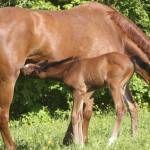Foal-Heat Diarrhea: A Common Occurrence

The relatively mild and short-lived diarrhea experienced by many foals when they are about seven to ten days old has been termed foal-heat diarrhea because it often coincides with the mare’s first estrous cycle after giving birth. Originally thought to occur because of hormonal changes in the mare’s milk, this disruption is now believed to be a result of normal changes in the intestinal tract’s bacterial and protozoal population and the gut’s ability to handle fluid. These changes occur rapidly as the foal’s gut matures. Foal heat diarrhea also usually coincides with the time that foals begin to nibble on the mare’s manure.
Foals with normal foal-heat diarrhea typically have several days of loose or watery stools. The have a normal temperature and don’t act sick, remaining active and interested in their surroundings, and they continue to nurse regularly. They may develop some skin irritation on the hind legs as feces run down and coat the hair. Washing the hind legs with soap and water, drying them, and applying petroleum jelly or zinc oxide will help this scalding to heal. Administering antibiotics as a treatment for foal diarrhea is not suggested, and can actually be harmful to the process of establishing a healthy population of microbes in the foal’s hindgut.
Not all diarrhea in young foals is the relatively harmless foal-heat diarrhea, however. Severe diarrhea lasting more than a few days, especially if the foal has an elevated temperature (normal is up to 101.5o F or 38.6o C) or is not nursing regularly, may indicate a much more serious condition. Owners should check with a veterinarian if the foal seems sick, has a fever, stops nursing, or acts colicky or lethargic. In young foals, rapid diagnosis and treatment of a viral or bacterial infection can save the foal’s life.








